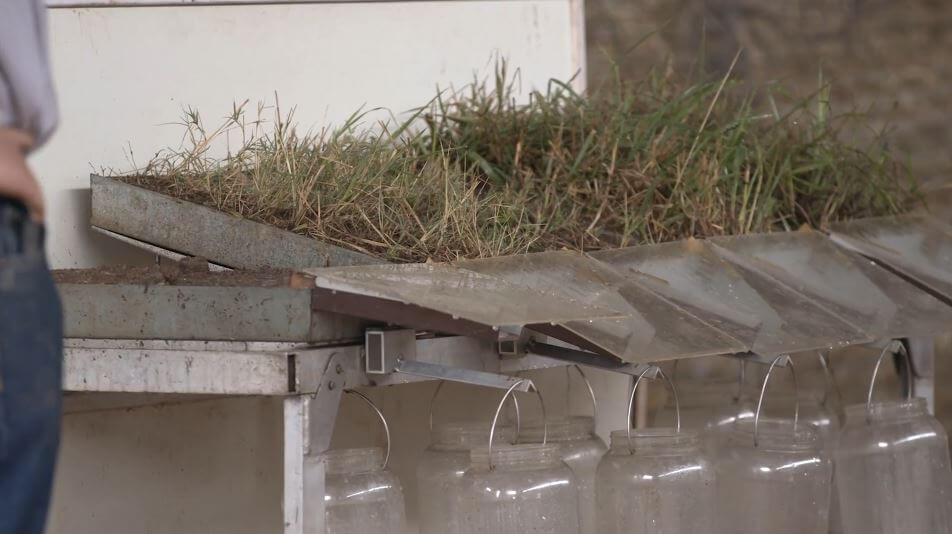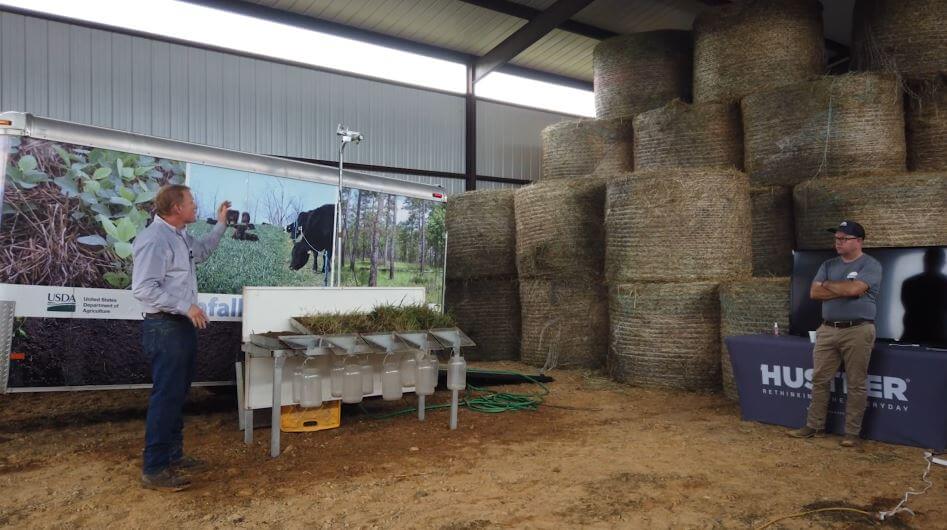Rainfall simulation shows importance of soil health and pasture management
Recently, we shared with you the video of the field day we organized in Arkansas (you can find the article by clicking here). We have decided to create a more detailed article on each guest’s performance as the topics covered are complex but extremely interesting for anyone interested in improving the quality and health of their soils on their farm or ranch.
This week we look at Jeremy Huff, USDA NRCS Arkansas State Grazing Lands Specialist’s presentation, who brought the fascinating rainfall simulator to show the effects that different grazing practices have on water retention and erosion.

The benefits of a healthy and productive pasture soil
This is no secret: soil is a living and life-giving natural resource. As world population and food production demands rise, keeping our soil healthy and productive is of paramount importance.
By farming using soil health principles and systems that include no-till, cover cropping and diverse rotations, more and more farmers are actually increasing their soil’s organic matter and improving microbial activity.
As a result, farmers are sequestering more carbon, increasing water infiltration, improving wildlife and pollinator habitat – all while harvesting better profits and often better yields. With soil health management, producers can increase profits and reduce costs and risk all while conserving the natural resources for the benefit of all.
The Natural Resources Conservation Service of the United States Department of Agriculture uses a unique traveling visual educational tool known as a ‘Rainfall Simulator’.
The rainfall simulator is traveling around the United States for demonstrations that exhibit beneficial effects of conservation practices such as no-till farming, cover crops, residue management, and prescribed grazing effects that improve soil health and water cycling on agricultural land.
The rainfall simulator simultaneously dispenses rain on up to five different land management systems. The runoff and infiltration from these different management scenarios are collected in two different sets of clear jars. The results are strikingly visible. For instance, the rainfall simulator can highlight how keeping various amounts of residue on the land can reduce sediment loss or the effectiveness of grass buffers to reduce sedimentation.
Testing different types of pasture management with the rainfall simulator
Jeremy Huff ran an experience with different plots of pasture samples to compare how they each coop with heavy rainfall. The full video is available at the bottom of this article.
The samples
The setup is made of four samples of grass and soil and one sample of loose soil. The four samples have been collected on the site so the soil is identical. The difference between them is how the plant canopy has been managed (ie. not grazed, short grazed, etc). The fifth sample doesn’t come from the same place, so it can’t be compared to the other, but Jeremy Huff wanted to include it in the experience to show an additional observation.
The first lot consists of samples on a slight inclination angle (typical inclination we can find or any farm or ranch)
- Dallisgrass and some weeds plot, barely grazed
- Fescue grass and some weeds plot, barely grazed
- Bermudagrass and some weeds, grazed down pretty short
- Bermudagrass and some weeds, grazed too short
The second lot consists of a sample with no inclination angle
- Tilled soil, quite loose. Without grass. Have been drying for two days, so still a bit of moisture in it.
The rainfall simulator is a pretty easy but clever machine to watch operates.
The water (simulating the rain) is collected in two separate sets of jars, split into two rows:
- The runoff water goes to the front jars
- The infiltration water goes to the back jars
Jeremy pointed out that he will try to simulate a strong short rain – due to how the device is made, it is hard to simulate 2 to 3 hours of slow rain.

What happened?
After a few minutes of “rain”, three noticeable results can be found:
- For plots 3 and 4 representing overgrazed pastures, the runoff is quite important and the water is very murky. It means that the effluents are going down the creeks or to the neighbor’s place. The nutrients are also drained away.
- For plots 1 and 2 representing barely grazed pastures, the water is much cleaner. A bit of water infiltration, but not in excess, shows that the soil drainage is good, but the soil still retains a necessary amount of water to feed the roots.
- For plot 5 representing the lose soil, even without an inclination angle, the audience noticed a lot of runoff, with a loss of topsoil and nutrients. Almost zero infiltration. Jeremy Huff explained that the more we break the soil structure, the more we create a “seal” over the topsoil, encouraging runoff and risks of soil erosion. Jeremy Huff admitted that it can sound a bit counter-intuitive as we could think that tilling the soil creates an infiltration network – which is a popular misconception.
A few tips to improve the health of the pastures
After the demonstration, Jeremy Huff explains that the ultimate goal for a healthy pasture is to hold water in order to hold the soil nutrients and create less runoff that is nt ideal for waterways and soil in general. The best is having a great root system that can develop with a good soil cover.
But how to achieve that?
Fertilizer is not always the answer. Often, when farmers or ranchers notice a poor pasture, they add fertilizer. Fertilizer is a great way to help improve soil health but as the rainfall simulator demonstrated, if you apply fertilizer on poor soil, you’ll lose most of it at the next rain due to the runoff created by poor soil.
The best is to wait that the soil has recovered a bit before applying the fertilizer – fertilizer would just go away if you put it over no or minimal grass.
How do you keep the ground covered?
- Avoid soil disturbances of any kind. Once the soil is disturbed or compacted, the soil profile is destroyed.
- Focus on good soil cover
- Try to apply the principles of rotational grazing
- Don’t graze down too short, leave leaves on the plants.
- Avoid feeding out your herd at the same place as you create compaction. If you compact the soil, no infiltration. Unrolling the hay is better than using hay rings or hay wagons, with less impact on the soil.
If you want to learn more about the different methodologies you can apply on your farm or ranch to improve the quality of your pastures, have a look at our previous articles:
- 8 Benefits of Rotational Grazing
- Increasing Soil Fertility and Forage Production through Pasture Management
- Ways to minimize the impact of hay feeding
- Improve your pasture for free with your bale feeding routine
- Some key differences between rotational, mob and holistic grazing
- Does it really make sense to ground-feed onto mud?
- The Art of Sustainable Hay Feeding in a Tough Economy


























